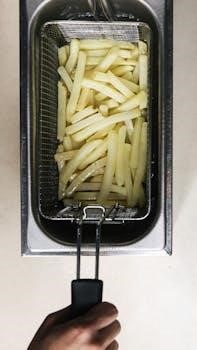
Air Fryer Cooking Times⁚ A Comprehensive Guide
Embark on a journey to master air frying with our comprehensive guide! Discover essential cooking times and temperatures for various foods․ Our resources include printable PDF charts and conversion tools, ensuring success in your air fryer adventures․ These tools will help you cook everything from meats to frozen foods․
Understanding Air Fryer Cooking
Air fryer cooking is a revolutionary method that utilizes rapid air circulation to cook food, achieving a crispy texture similar to deep frying but with significantly less oil․ This process not only reduces fat content but also speeds up cooking times compared to traditional ovens․ Understanding how air fryers work is crucial for achieving optimal results․ The core of air frying involves a heating element and a powerful fan that circulates hot air around the food․ This constant circulation ensures even cooking and browning․ It’s important to note that cooking times and temperatures vary based on the type of food, its size, and the specific air fryer model․ Factors like preheating and proper food placement also impact the outcome․ By grasping these fundamentals, you’ll be better equipped to navigate air fryer cooking, using resources like our air fryer cooking times PDF charts to guide you to culinary success․ These charts provide a helpful starting point to understand and adjust cooking times․
The Need for Air Fryer Cooking Time Charts
Air fryer cooking, while convenient and efficient, requires precision, and that’s where air fryer cooking time charts become indispensable․ These charts serve as a vital reference, eliminating guesswork and helping users achieve perfectly cooked meals every time․ Without a reliable guide, it’s easy to undercook or overcook food in an air fryer, leading to disappointing results․ Given the speed at which air fryers cook, precise timing is essential for both flavor and food safety․ An air fryer cooking time chart compiles recommended cooking times and temperatures for a variety of foods, including meats, vegetables, and frozen items․ These charts are crucial for consistent cooking results, especially for those new to air frying; They also aid in converting traditional oven recipes for air fryer use․ Having a handy PDF version ensures quick access to this vital information, enabling anyone to confidently utilize their air fryer․ These charts are a great tool for both beginners and experienced users, simplifying the cooking process․

Free Printable Air Fryer Cooking Time PDF Charts
Unlock the full potential of your air fryer with our collection of free printable air fryer cooking time PDF charts․ These charts are designed to simplify your cooking process, offering a convenient and reliable reference for various foods․ Available in a downloadable PDF format, these charts can be easily printed and kept handy in your kitchen․ They are an essential tool for both beginners and experienced air fryer users, providing recommended times and temperatures for meats, seafood, vegetables, and frozen items․ The charts are organized to make it easy to find the specific food you’re cooking․ They will guide you to the proper settings, helping you achieve perfect results every time․ These free resources eliminate the guesswork from air frying, ensuring your meals are cooked to perfection, whether you’re preparing a quick weeknight dinner or a special weekend feast․ Access these charts to enhance your air frying experience and enjoy consistent results with every meal․ The portability of a PDF chart is also very useful․
Converting Oven Recipes to Air Fryer Recipes
Adapting your favorite oven recipes for air fryer cooking is easier than you might think, and it opens up a world of possibilities for quicker, crispier meals․ The key to successfully converting oven recipes is understanding how the air fryer’s rapid circulation of hot air affects cooking times and temperatures․ Generally, when converting an oven recipe, you’ll want to reduce the temperature by about 25 degrees Fahrenheit and decrease the cooking time by approximately 20-25%․ However, these adjustments can vary depending on the specific food and its density․ It’s always best to check your food periodically during the initial cooking attempts to ensure it doesn’t overcook․ For dense or large items, you may need to slightly reduce the temperature and time more gradually․ Smaller items may require less reduction in time․ Always remember that an air fryer operates differently than an oven, and a little experimentation might be necessary to get the perfect result․ These adjustments will help you convert your recipes effectively, ensuring delicious meals with the convenience of air frying․
General Rules for Time and Temperature Conversion
When venturing into the realm of air frying, understanding the fundamental rules for time and temperature conversion is essential for success․ As a general guideline, when adapting oven recipes for air frying, it’s recommended to reduce the oven temperature by approximately 25 degrees Fahrenheit․ This adjustment accounts for the air fryer’s efficient circulation of hot air, which cooks food faster than a conventional oven․ In terms of time, a good starting point is to reduce the oven cook time by about 20-25%․ However, these are just general rules, and the specific adjustments needed will vary based on the food type and its density․ For instance, foods with high moisture content might need slightly less time reduction, while denser foods might require more․ It is also essential to monitor the food closely during the initial cooking process, checking for doneness and adjusting the time as required․ Remember, air fryers vary in power and efficiency, so these rules serve as a starting point․ Experimentation and careful observation are key to mastering the art of air fryer cooking․
Specific Food Cooking Times⁚ Meats, Seafood, Vegetables
Navigating the specific cooking times for different food categories in an air fryer is crucial for achieving perfectly cooked meals․ When it comes to meats, factors like thickness and type significantly impact the required time․ For example, pork chops typically need around 12-15 minutes at 375°F, while a meatloaf may require 35-45 minutes at 325°F․ Seafood, being more delicate, generally cooks faster; salmon, for example, often cooks in 5-7 minutes at 400°F․ Vegetables also vary greatly in cooking times․ Heartier vegetables like potatoes might take 20-25 minutes at a higher temperature of around 400°F, while leafy greens might only need a few minutes․ It’s vital to remember that these are approximate times, and the specific size and desired level of doneness will influence the final cooking time․ Always use a meat thermometer to ensure meats and seafood are cooked to a safe internal temperature․ Regular checks and adjustments are key to perfect air-fried food․
Cooking Times for Frozen Foods in Air Fryers
Air fryers are incredibly convenient for cooking frozen foods, offering a quick and crispy alternative to traditional methods․ However, understanding the correct cooking times is crucial for achieving the best results․ Frozen french fries, a popular choice, often require 15-20 minutes at around 400°F, depending on their thickness and desired crispness․ Frozen chicken nuggets and similar breaded items usually need about 10-15 minutes at the same temperature, flipping halfway through to ensure even cooking․ Frozen vegetables, like broccoli or peas, can be cooked in about 8-12 minutes at 380°F, though stirring them occasionally is essential for even heat distribution․ Remember, these times are starting points, and it is always a good idea to check for doneness before adding more time․ If the frozen product includes air fryer instructions, reference them to determine the temperature and a ballpark cook time․ Always avoid overcrowding the air fryer basket, as this can lead to uneven cooking, which may require more time․

Basket vs․ Tray Style Air Fryer Cooking Time Differences
When it comes to air fryers, the two primary designs, basket and tray styles, can lead to slight differences in cooking times․ Basket-style air fryers, with their compact, enclosed design, tend to circulate hot air more rapidly and directly around the food, potentially resulting in slightly faster cooking times compared to tray-style models․ Tray-style air fryers, which often resemble small ovens, typically have more interior space, making them ideal for cooking larger quantities or items like pizzas․ However, this larger space might mean that the heat distribution is less concentrated, leading to slightly longer cooking times․ Moreover, the food placement on a tray can be a factor, and it’s often beneficial to rotate the trays or move the food around to ensure even cooking․ Generally, the temperature settings are similar across both types, but it’s important to keep an eye on your food and use the recommended time as a starting point․ It is also advisable to consult the manufacturer’s manual for specific guidelines for your appliance․
Air Fryer Cheat Sheets⁚ Magnetic and Printable Options
Air fryer cheat sheets are invaluable tools for both beginners and experienced users, offering quick and easy reference to cooking times and temperatures․ These cheat sheets come in various formats, with magnetic options being particularly convenient for sticking directly onto your refrigerator for immediate access․ Magnetic cheat sheets are typically durable and easy to clean, perfect for a busy kitchen environment․ Printable cheat sheets, often available in PDF format, provide a more flexible option, allowing you to keep a copy in your recipe binder or near your air fryer․ These printable versions can be easily replaced if they become worn or stained․ Both magnetic and printable cheat sheets usually include a comprehensive list of common foods, from meats and vegetables to frozen items, and are designed to help you eliminate guesswork and achieve consistent results․ Many of these sheets are also available in both Fahrenheit and Celsius, catering to a global audience․ Whether you choose magnetic or printable, these cheat sheets are an essential addition to your air fryer toolkit․
Using an Air Fryer Calculator for Conversions
An air fryer calculator is an indispensable tool for converting traditional oven recipes into air fryer-friendly instructions․ This handy device simplifies the process of adjusting cooking times and temperatures, ensuring your favorite dishes are perfectly cooked in your air fryer․ To use an air fryer calculator, you typically input the original oven temperature and cooking time․ The calculator then generates the equivalent settings for your air fryer, often recommending a slightly lower temperature and significantly shorter cooking time․ Many calculators also offer guidance on adjusting cooking times for different types of food, such as meats, vegetables, or baked goods․ These calculators eliminate the guesswork involved in adapting recipes, preventing undercooked or overcooked results․ Some air fryer calculators are available as online tools, while others can be found in the form of smartphone apps․ With an air fryer calculator, you can confidently experiment with various recipes and enjoy the convenience and speed of air fryer cooking․ These tools are a must-have for anyone looking to fully utilize their air fryer’s capabilities․
Tips for Achieving Optimal Air Fryer Results
To achieve optimal results with your air fryer, consider several key tips․ Firstly, always preheat your air fryer for a few minutes before adding food; this helps ensure even cooking and crispier results․ Avoid overcrowding the basket or tray; cooking in batches can help ensure the air circulates properly around the food․ When air frying, it is beneficial to flip or shake your food halfway through the cooking time to ensure even browning and crisping․ Lightly coat foods with oil or cooking spray, as this enhances browning and texture․ Consider using a meat thermometer to ensure your proteins are cooked to a safe internal temperature․ When converting oven recipes, reduce the temperature by 25 degrees Fahrenheit and the cooking time by approximately 20-25%․ Always monitor your food during the cooking process, as air fryers can vary in their performance․ These tips will help you achieve consistent and delicious results every time you use your air fryer․ Consistent practice and experimentation will lead to the best results․
Troubleshooting Common Air Fryer Cooking Issues
Encountering issues with your air fryer is common, but most problems have simple solutions․ If your food is not cooking evenly, make sure you aren’t overcrowding the basket or tray and that you are flipping your food halfway through the cooking process․ If your food is not getting crispy, try increasing the cooking time slightly or raising the temperature by a few degrees, ensuring a light coating of oil beforehand․ If your food is burning, lower the temperature and check it more frequently․ If you see smoke, there may be too much fat in the food․ Consider reducing the fat content next time or adding a bit of water to the bottom of the air fryer․ Sometimes, inconsistent results can be due to not preheating the air fryer before cooking․ Also ensure that your air fryer is clean․ Lastly, always double-check that you are using appropriate cooking times and temperatures for the food you are preparing․ These are common issues and can usually be resolved with simple adjustments․

